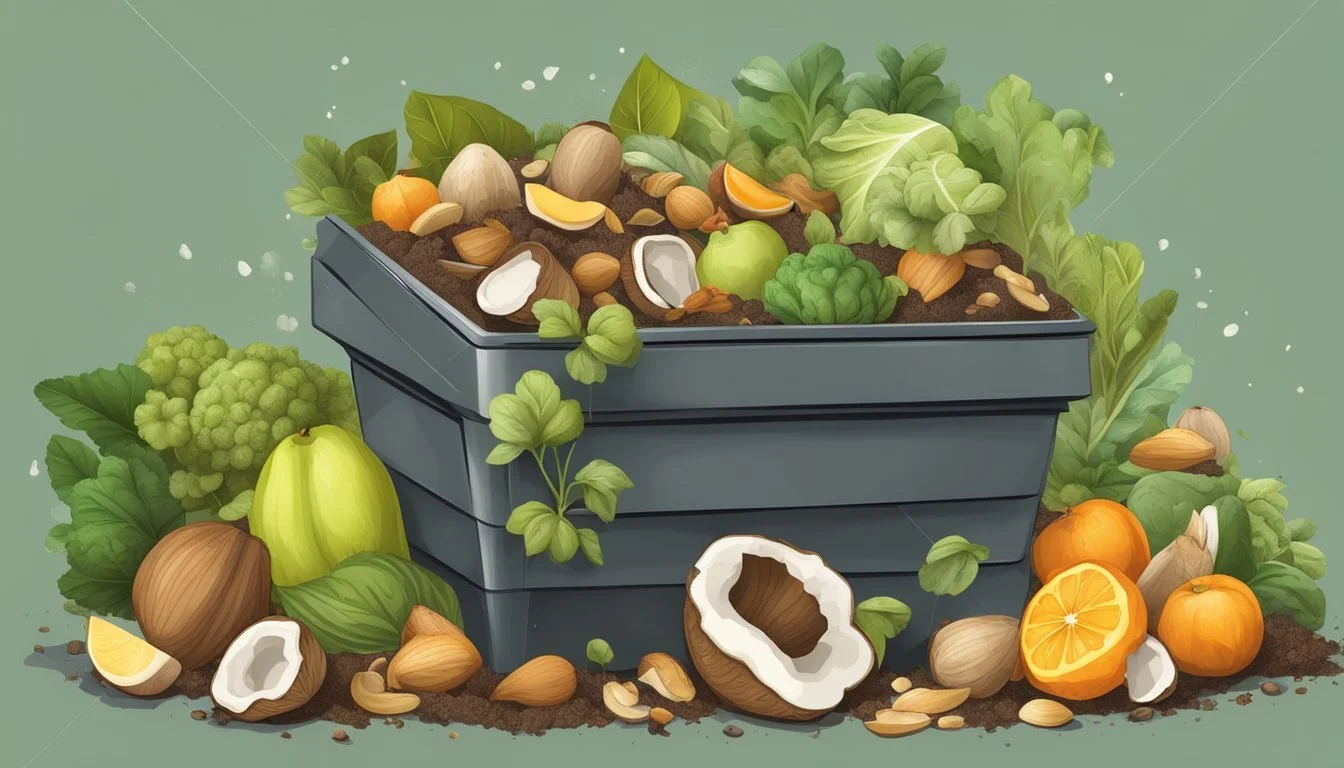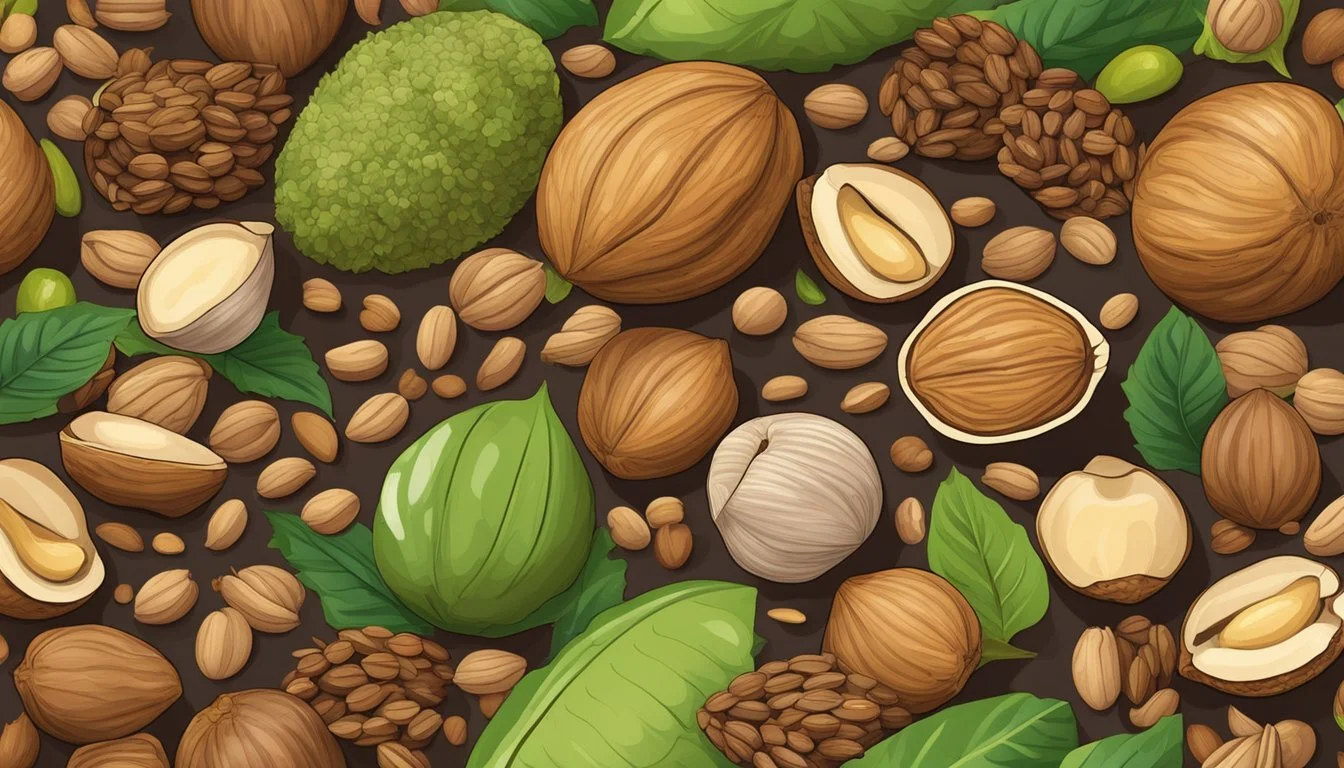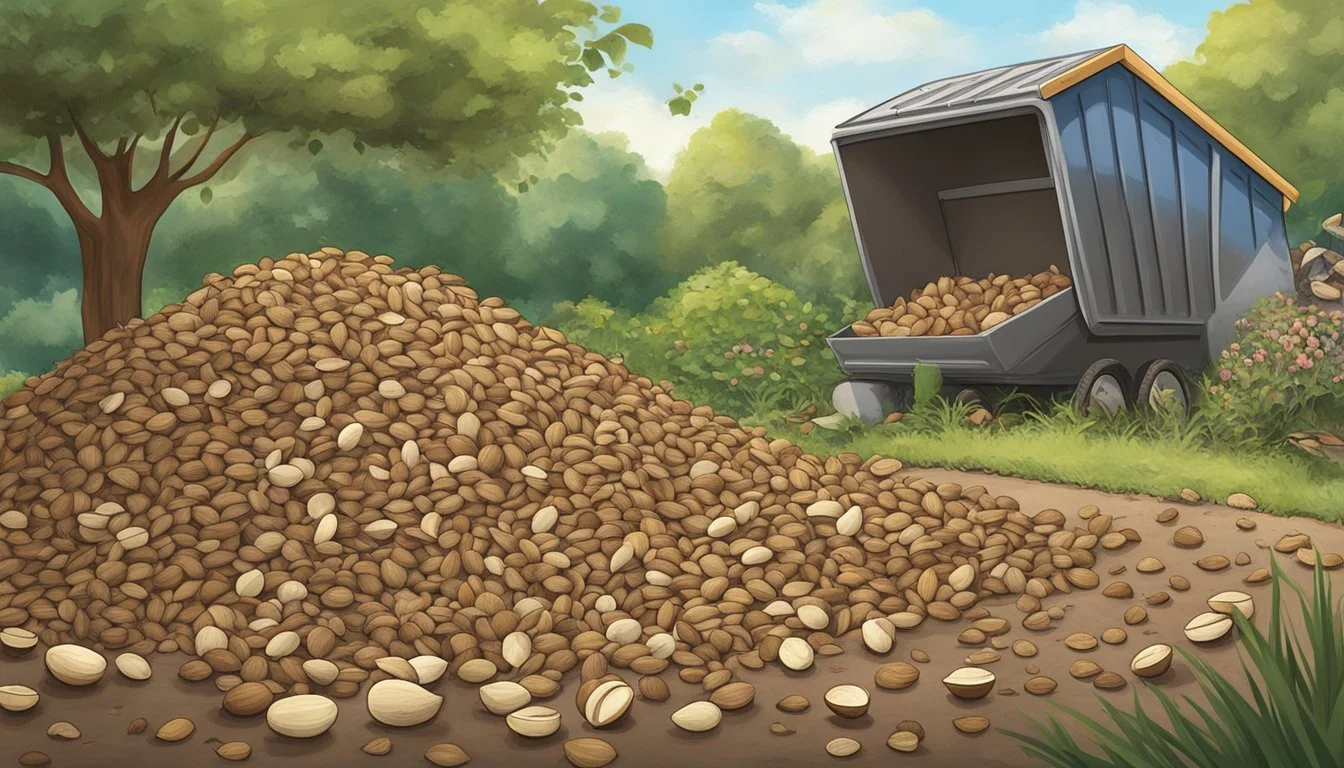Can You Compost Nut Shells?
Unveiling the Truth about Organic Recycling
Nut shells are an often-overlooked component when it comes to creating compost. Composting nut shells is indeed a viable practice, and they can serve as a valuable source of carbon in the compost pile, which is crucial for balancing the nitrogen-rich materials like food scraps and lawn clippings. However, due to their hardy and woody nature, nut shells take a longer time to break down, with decomposition periods ranging from six months to two years.
Gardeners looking to incorporate nut shells into their compost should plan for these extended timelines and also consider breaking the shells into smaller pieces to expedite the process. Nonetheless, the benefit of adding nut shells, like those from pistachios or peanuts, extends beyond their carbon contribution—they also enhance the physical structure of the compost, adding bulk and improving aeration, which is critical for proper composting dynamics.
When composting nut shells, it is essential to bear in mind that some shells, such as those from walnuts, contain compounds that might be toxic to certain plants. Thus, to safeguard plant health, these types of shells should be avoided or composted with caution. By understanding the particular characteristics of nut shells, composters can effectively integrate them into their organic waste recycling efforts.
Understanding Composting Basics
This section will explain the fundamental principles of composting, including the roles of nitrogen and carbon, the balance of materials necessary, and the essential process of decomposition.
What Is Composting?
Composting is a natural process that transforms organic materials like food scraps and yard waste into a rich soil amendment known as compost. It involves the controlled decomposition of organic matter by microorganisms such as bacteria and fungi, resulting in a nutrient-dense product.
The Role of Nitrogen and Carbon in Composting
The decomposition process in a compost pile hinges on the balance between nitrogen and carbon. Nitrogen, found in "green ingredients" like vegetable scraps, provides proteins and amino acids necessary for the growth of decomposing microorganisms. Carbon, present in "brown ingredients" such as dry leaves and wood chips, offers energy to these microbes through carbohydrates.
Nitrogen-rich materials (Green ingredients):
Grass clippings
Vegetable scraps
Coffee grounds
Carbon-rich materials (Brown ingredients):
Dry leaves
Wood chips
Cardboard
Green and Brown Ingredients
The compost pile should maintain a balance between green and brown ingredients. A general recommended ratio is 1 part green to 3 parts brown. Green materials quickly provide nitrogen, while brown materials slowly furnish carbon, ensuring a steady energy source for the composting organisms.
Ideal ratio: 1 part green to 3 parts brown
Decomposition Process Fundamentals
The compost pile requires four crucial elements to effectively support decomposition: heat, oxygen, moisture, and the aforementioned balance of materials. Microorganisms break down organic matter, generating heat, which further accelerates the process. Adequate oxygen and moisture levels are necessary to sustain microbial activity without causing anaerobic conditions or drying out the pile.
Essential elements for composting:
Heat - Speeds up microbial activity.
Oxygen - Prevents anaerobic decomposition and odors.
Moisture - Moist as a wrung-out sponge is optimal.
Balance - Proper green to brown ratio maintains efficiency.
By managing these factors, one can facilitate a quicker and more efficient decomposition, producing high-quality compost beneficial for garden and plant growth.
Types of Composting
Hot Composting
Hot composting is a method designed to rapidly break down organic matter. The process requires active management, including maintaining a balanced mix of nitrogen-rich green materials, such as vegetable scraps or grass clippings, and carbon-rich browns like dried leaves or nut shells. The key to successful hot composting is ensuring consistent moisture and regular turning to oxygenate the pile, which should generate heat of between 120°F to 160°F. This heat is critical for quick decomposition and killing off weed seeds and pathogens.
Cold Composting
Cold composting, in contrast, is a slower process that involves less maintenance. One simply accumulates organic waste such as food scraps, yard waste, and nut shells in a compost bin or heap and lets nature take its course. The lack of active management means this method is less labor-intensive, but it can take months to a few years for materials to fully decompose. Cold compost piles do not generate the same level of heat as hot compost piles, which means they may not break down weed seeds and pathogens.
Can You Compost Nut Shells?
Nut shells are a common byproduct in many households and can be effectively composted. They contribute carbon-rich material to compost bins, although they do present specific challenges due to their tough nature.
Nut Shells in Composting
Nut shells are considered brown compost materials due to their carbon content. They are suitable for composting, particularly varieties such as peanuts, pistachios, and almonds. The composting of nut shells contributes to a more balanced compost pile by providing necessary bulk that aids in maintaining proper aeration and structure.
Benefits of Nut Shells in Compost
Aeration: Due to their structure, nut shells create pockets of air when mixed into a compost pile, which is essential for aerobic bacteria to thrive.
Structure: They help in maintaining the pile's structure, preventing the compost from becoming too dense and wet.
Slow Decomposition: Nut shells break down slowly, releasing nutrients over time and creating a more long-lasting amendment for soil.
Challenges of Composting Nut Shells
Decomposition Rate: Nut shells decompose at a slower rate than other organic materials, taking anywhere from 6 to 24 months to break down fully.
Preparation: To hasten decomposition, it's advised to crush or break the shells into smaller pieces before adding them to the compost pile.
Plant-Based Toxins: Some shells, like walnut shells, may contain compounds that are toxic to certain plants, and therefore should be composted with caution.
Nut Shell Specifics
In composting, nut shells are considered a valuable source of carbon, but they decompose at different rates. It's essential to understand the specifics of each type to effectively incorporate them into a composting system.
Peanuts and Peanut Shells
Peanut shells are an excellent addition to compost piles as they bring carbon and help create a balanced compost. They should be crushed or broken down to speed up the composting process. One should also be cautious if peanut shells are sourced from a product that may have included salt or flavorings, as these additives could be harmful to the compost.
Composition: Mostly carbon, aiding microbial activity in compost.
Decomposition Rate: Moderate; faster if crushed.
Walnuts and Walnut Shells
Walnut shells are tougher and take longer to decompose compared to peanut shells. They also have a unique consideration: juglone. Juglone is a compound found in walnuts, especially black walnuts, that is toxic to certain plants. Composting walnut shells may introduce small quantities of juglone into the compost, so it’s important to use the resulting compost carefully.
Composition: High carbon content.
Decomposition Rate: Slow; breaking them down helps.
Note: Juglone can be an issue for sensitive plants.
Pistachio and Hickory Nut Shells
Pistachio nut shells and hickory nut shells both break down over a similar timeline. They do not have the same concerns with juglone as walnut shells but still should be broken or crushed to decompose more efficiently. Both types of shells are resistant to fungal diseases and can help introduce good bulk and aeration into the compost.
Composition: High in carbon, sturdy structure.
Decomposition Rate: Slow; smaller pieces decompose faster.
Advantage: Resilient to fungal diseases, aiding in a healthy compost mix.
Preparing Nut Shells for Composting
Before adding nut shells to a compost pile, one must prepare them properly to enhance their decomposition process. Preparing involves breaking down the shells into smaller pieces and ensuring a balanced mix with other compost materials.
Crushing or Grinding Nut Shells
For efficient composting, nut shells should be crushed or ground to reduce their size. Smaller pieces have a larger surface area that expedites microbial activity, leading to faster decomposition. They can be crushed manually with a hammer or with a mortar and pestle, depending on the volume. For larger quantities, a shredder or grinder suitable for hard materials might be necessary. The aim is to achieve pieces small enough to blend with other compost elements without overwhelming them.
Method for Crushing:
Manual: Use a hammer, mortar and pestle
Mechanical: Utilize a shredder or grinder for larger volumes
Balancing Nut Shells with Other Compost Materials
Nut shells are considered brown compost material, indicating their high carbon content. To maintain a healthy compost, it is pivotal to balance these carbon-rich shells with nitrogen-rich green ingredients such as vegetable scraps, fruit peels, or grass clippings. A general guideline is to maintain a ratio of browns to greens, often recommended as 2:1 or 3:1.
Optimal Compost Ratio:
Browns (carbon-based ingredients like nut shells, sawdust, dry leaves)
Greens (nitrogen-based ingredients like kitchen scraps, wet garden waste)
Nut shells also act as a natural bulking agent in the compost pile, promoting airflow and preventing compaction. This helps to avoid anaerobic conditions which can lead to bad odors and slower decomposition. They should be mixed thoroughly with other materials to ensure even distribution and aeration. Regular turning of the compost pile facilitates this process, contributing to the creation of rich and fertile compost.
Safe Composting Practices
Composting nut shells can be beneficial for your compost pile, as they add carbon-rich material and aeration, but it's essential to be aware of certain types of nuts and proper compost management techniques.
Avoiding Toxic Elements
Certain nut shells, specifically black walnut, contain a compound known as juglone, which is toxic to many plants. It is crucial for gardeners to exclude black walnut shells from their compost piles to prevent introducing this harmful substance into their garden's ecosystem.
Managing Compost Pile Moisture and Aeration
A successful compost pile relies on the right balance of moisture and aeration. Nut shells are beneficial in adding bulk and creating air pockets which promote oxygen flow. However, they should be mixed properly with other green materials to maintain optimum moisture levels. A compost should feel like a wrung-out sponge—moist but not dripping. Regular turning of the pile will help distribute air and moisture evenly.
Using Composted Nut Shells
Composted nut shells provide gardeners with versatile options for enhancing soil health and landscaping. These robust byproducts, once fully decomposed, offer both protective and nutritional benefits to garden environments.
As Mulch
Nut shell mulch serves as a durable, visually appealing layer that retains soil moisture and suppresses weed growth. When applied to garden beds, they create an insulating barrier that moderates soil temperature, benefitting plant roots. Gardeners typically lay a 2-3 inch layer of nut shell mulch around plants, ensuring a spread that extends to the drip line but avoids direct contact with plant stems.
As Soil Amendment
Incorporating finely composted nut shells into garden soil acts as a soil amendment, enhancing soil structure and fertility. They contribute to improved aeration and drainage, which are crucial for healthy root development. Before being mixed into soil, nut shells should be thoroughly composted down to a finer texture to facilitate integration and nutrient availability. It is recommended to work this amendment into the top few inches of soil to enrich the planting area and support robust plant growth.
Common Concerns and Solutions
When composting nut shells, two primary concerns are controlling pests and diseases and ensuring an effective decomposition rate. Addressing these can help maintain a healthy compost environment conducive to plant growth.
Dealing with Pests and Diseases
Nut shells in compost can occasionally attract pests and may be susceptible to fungal diseases like southern blight. To mitigate these issues, it is essential to:
Maintain proper moisture levels in the compost. Excessive dampness can promote fungus growth, so the pile should be kept aerated and not too wet.
Turn the compost regularly to discourage pests. This also exposes any developing pest nests to the surface, making it less inviting for them.
Ensure nut shells are clean and free from any salt or seasonings before composting to avoid attracting pests.
Ensuring Proper Decomposition Rate
Nut shells are naturally tough and can take longer to decompose. To accelerate the decomposition process and support the activity of beneficial microorganisms:
Crush or grind the shells into smaller pieces to increase their surface area and make it easier for microorganisms to break them down.
Balance the compost with a mix of green (nitrogen-rich) and brown (carbon-rich) materials. Nut shells are high in carbon; therefore, they should be paired with green materials to maintain a balanced compost.
By implementing these practices, composting nut shells can be both feasible and beneficial for soil health and plant growth, stacking up to an effective composting strategy.
Tips for Composting Nut Shells
Composting nut shells is beneficial as they add carbon to your compost pile. However, their tough, woody structure means they break down slower than other organic materials. Here are some guidelines:
Balance: Nut shells are a carbon source in your compost, so ensure a good mix with nitrogen-rich materials. Examples include coffee grounds, tea bags, and legume plants.
Size Matters: Breaking shells into smaller pieces accelerates decomposition. One might use a hammer to crack tougher shells like walnuts.
Patience is Key: A standard timeline for nut shells to decompose is 6 to 24 months. Regularly turning your compost helps to speed this up.
Complementary Materials: Adding coffee grounds and filters, eggshells, or tea bags helps to balance the compost's moisture and nutrient profile.
Avoiding Smells and Pests: While composting nut shells, one should keep the pile well-aerated to prevent unpleasant odors and deter pests.
Remember, the natural breakdown of nut shells enriches the soil with nutrients over time, enhancing your garden's health.
Other Considerations
When adding nut shells to compost, gardeners should consider not only the decomposition process but also the broader environmental implications and the specific contributions to garden soil health.
Environmental Impact
Nut shells in compost represent an effective way to reduce waste and promote a more sustainable cycle in the garden. By diverting nut shells from landfills, gardeners minimize methane production, a potent greenhouse gas released during the anaerobic decomposition of organic matter in landfills. However, the type of nut shells and their source should be contemplated, favoring organic or pesticide-free shells to prevent the introduction of chemicals into the compost that could lead to soil and water contamination.
Nutritional Contributions to Garden Soil
While nut shells are primarily a source of carbon in the compost pile, which serves to balance the nitrogen-rich "green" materials, their nutritional contributions to garden soil should not be overlooked. They slowly release trace minerals as they break down, which can include calcium, magnesium, and potassium, although in small quantities. These nutrients contribute to creating a richer growing medium over time, but gardeners should note that the decomposition rate is slow, necessitating patience for the full benefits to be realized in the gardening soil.
Conclusion
Composting nut shells is a viable practice that can enhance garden soil composition. Nut shells, being high in carbon, serve as "brown" materials that add bulk and improve the structural integrity of compost. They also promote the essential balance between carbon and nitrogen levels within a compost pile.
When adding nut shells to compost, one should be aware that they decompose more slowly than softer organic materials. To hasten decomposition, shells can be crushed or ground. Including nut shells in a compost mix contributes to the creation of a nutrient-rich humus beneficial for plant growth.
Incorporating nut shells into a compost pile is not only an efficient way to reduce kitchen waste but also supports sustainable gardening practices. By doing so, gardeners can enhance the fertility of the soil while participating in eco-friendly waste management.





